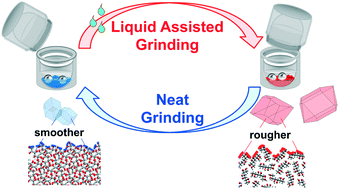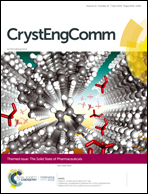On the prevalence of smooth polymorphs at the nanoscale: implications for pharmaceuticals†
Abstract
We demonstrate, for four different systems of pharmaceutical relevance, that ball mill grinding leads to different polymorphic transformations depending on the milling conditions. In all four cases, the commercial polymorph converts to a different polymorph upon ball-mill neat grinding (NG). This transformation can be reversed by grinding the so obtained polymorph in the presence of small amounts of solvent (LAG), leading back to the commercial polymorph. Scherrer particle size determinations reveal that NG conditions almost always lead to smaller particle sizes in the nanometer length scales. Computational studies confirm that polymorphs obtained by the specific ball mill LAG conditions reported correspond to the lowest lattice energy forms. Our study further confirms our earlier conclusions that, at the nanoscale, polymorphs with higher lattice energies can become the thermodynamically stable forms if their surfaces are more stable than those of the polymorphs obtained by LAG. We found, however, one exception to this trend in D-sorbitol. We observe that polymorphs with smoother surfaces (low roughness) are usually the ones observed by NG. This observation points to a link between surface roughness and surface stability.

- This article is part of the themed collections: The Solid State of Pharmaceuticals and Editor’s Collection: Polymorphism in Molecular Crystals


 Please wait while we load your content...
Please wait while we load your content...